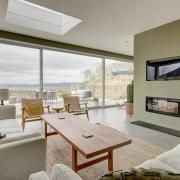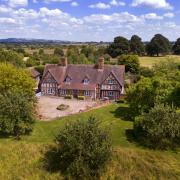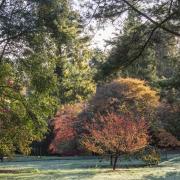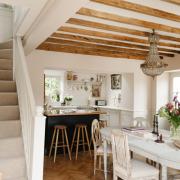Neatly-clipped pyracantha framing an outbuilding door is a sign that someone at Oxleaze Farm likes gardening, but gives no indication of the delight that awaits on the other side of the wall.
Borders full of summer colour, a kitchen garden brimming with crops, topiary and wildflowers: the garden ranges across many styles and embraces all seasons.
It’s the work of Carole ‘Chipps’ Mann who inherited the 'bones' of the garden from her mother-in-law.
'The walls, the trees and the paths were all her doing, which was lovely and a good canvas to build upon,' says Chipps, who moved to the farm near Lechlade with her husband, Charles, 41 years ago.

The garden has changed under her tenure, partly because she has less help but also due to her preference for a more natural style of gardening, what she describes as the 'country garden' feel.
'I’m a sucker for a self-seeder so if it’s decided to put itself somewhere, I’m very happy to let it stay on the whole.'
This country feel is reinforced by paths made of stone dug up by ploughs on the farm over generations: 'They’re not quite square but it’s a lovely Cotswold crazy paving that I think helps the softness of the place.'
Set against that is structure in the form of clipped yew hedges, topiarised box and mop-headed Portuguese laurel that help to divide the garden and provide year-round interest.
An early influence was Rosemary Verey at nearby Barnsley – Chipps’ mother-in-law suggested she volunteer to help the designer.
'I used to drive her to her designing jobs, and literally just soaked up everything she said,' recalls Chipps. 'That really set me on my path.'
The garden does have hints of the Verey style, not least in the vegetable garden with its mix of flowers, fruit and vegetables reminiscent of the famous potager at Barnsley House.

The original vegetable garden at Oxleaze Farm was much bigger – 'I literally carved it in two. It was just a mass of brown soil, which I thought was very intimidating.'
Raised beds, made using a mix of oak sleepers and Corten steel, and cultivated using the 'no-dig' method, are now filled with flowers – lavenders, dahlias and alliums – and vegetables, including broad beans, potatoes, celery leaf, lettuces and carrots.

Trained apples and pears span one path, underplanted with alliums and astrantias, while a rose arch adds height and colour to another. There are flowers for cutting, packed fruit cages, and tayberries and loganberries scrambling over specially- commissioned supports.
Alongside the vegetable garden, what was once mown grass is now meadow. Its season starts with species Crocus tommasinianus followed by fritillaries, camassias, and alliums that have been moved out from the main garden. These mix with wildflowers, including cowslips, knapweeds and ox-eye daisies. There are ornamental prunus and an avenue of Crataegus lavallei.

Chipps’ favourite area was once the other half of the vegetable garden, which later became a play area for her now adult children. Deciding she wanted a change in level – the rest of the garden is flat – she started digging it out by hand before her husband took pity and brought in a digger.
The result is a wildlife pond and bog garden that in summer is dominated by the large leaves and architectural shape of Gunnera tinctoria, angelica, ferns, Siberian irises, skunk cabbage, and hostas.
The family eat out in what is known as ‘Tuscany’, an area sheltered by yew hedges with arches and alcoves, fastigiate box and terracotta urns adding an Italian touch.
More seating is found near the house with views over the main flower borders. Cultivating these has been dramatically improved by the installation of an irrigation system: 'I probably would have given up gardening without it,' says Chipps. 'It was so sad the way things struggled.’

Now she’s able to grow roses – always difficult on Cotswold brash – and there are many throughout this area, including ‘Boscobel’, ‘James Galway’ and ‘Meg’, which scrambles over a wall that was added to create a smaller, more enclosed area.
The borders are planted so that no bare earth can be seen – "If you see soil, you’re bound to get a weed."

Alongside the commonly-grown astrantia, thalictrum, allium and phlox are more unusual plants, including Digitalis lutea, Scilla peruviana, and Peltaria alliacea, with dahlias and tithonias among the seasonal stars added to extend the display.
'Always at the back of my mind is that things won't stop at the end of June. The autumn is as important as the summer.'
Indeed, the Rosemary Verey influence can be seen in this successional planting with layers of bulbs and perennials under shrubs and trees.

A swing seat is sheltered by a vine in an area enclosed by an inherited box hedge that is now sculpted into curves with a window giving views over fields.
Another part that she redesigned used to be a large peony bed – 'If it was a good year, you had about two weeks of absolute beauty and joy and if it was a bad, wet year, you had about two hours of beauty and joy.'
It’s in full view from the house so is now planted for year-round interest, with hellebores, roses, Hydrangea paniculata ‘Limelight’ and wisteria in the mix.

At one end, a large gazebo, softened by white centranthus, has replaced a shed that was falling down. It shelters a table and chairs, providing a cool space for al fresco meals.
Beyond liking to pair a climbing rose with a clematis, Chipps doesn’t go for a lot planning when it comes to her borders.
'I never sit down with a pencil and paper and think ‘I'm going to think really hard about what I'm going to plant here.’ Happy accidents happen and if it works, I repeat it somewhere else,' she explains.

It results in an informality that suits this rural garden set in the Cotswold countryside.
'I was told once that a garden should look as if the gardener had died a few weeks ago which I'm quite encouraged by,' says Chipps.
It’s this relaxed atmosphere that’s an essential part of Oxleaze Farm’s charm.

Instagram: @thechattygardener
Facebook: The Chatty Gardener
X: @ChattyGardener
© Mandy Bradshaw



























